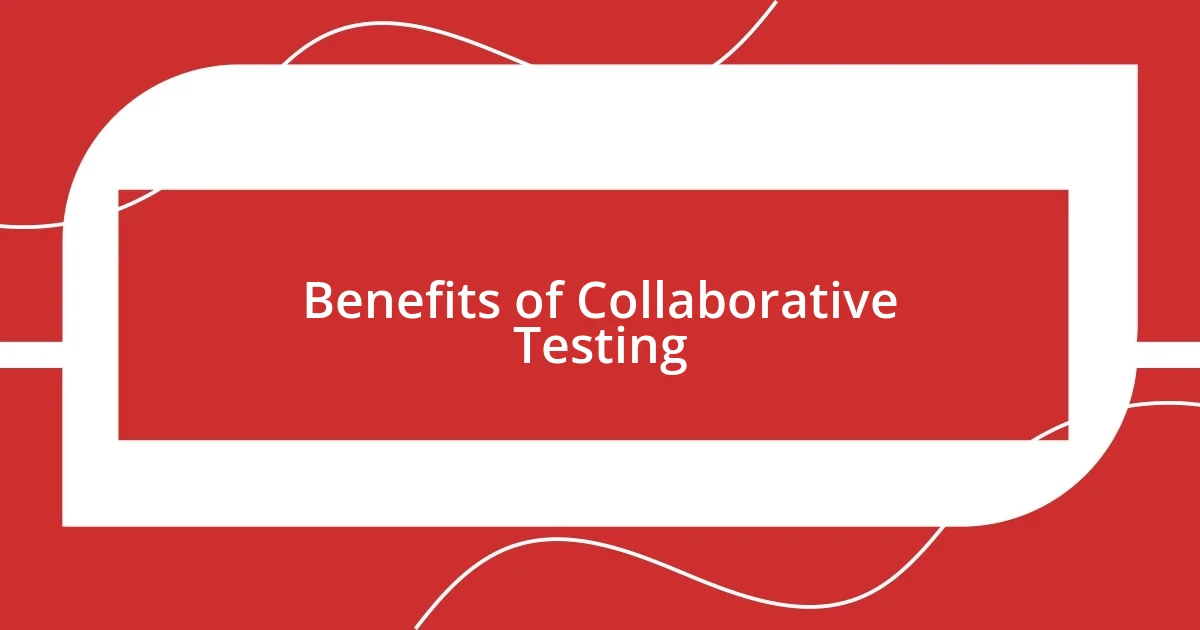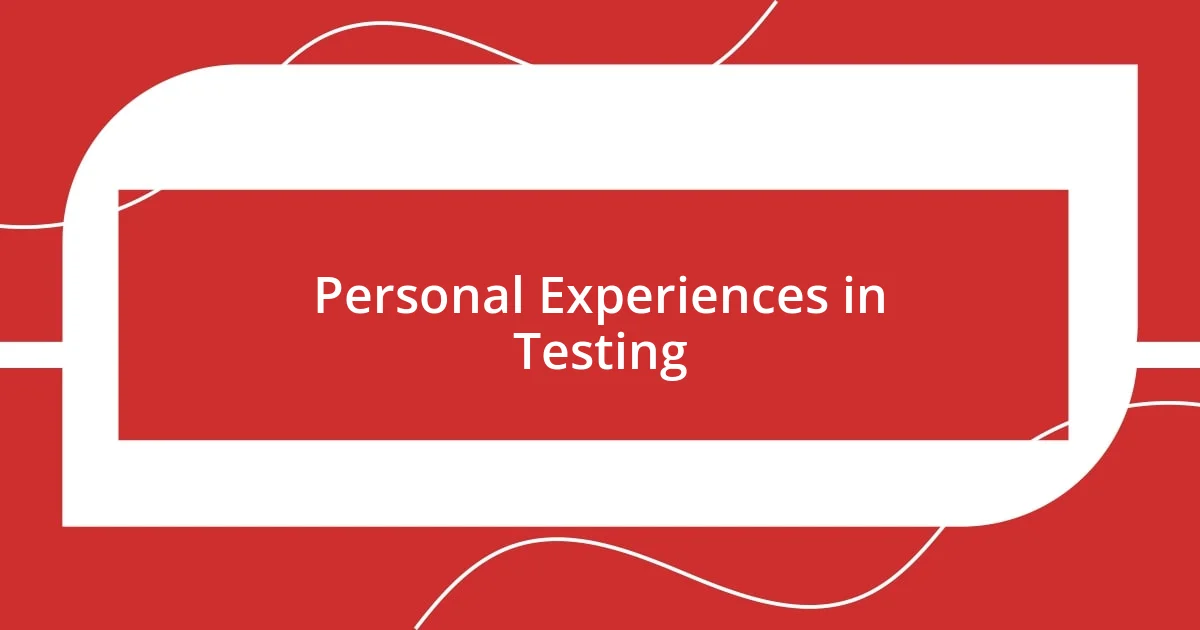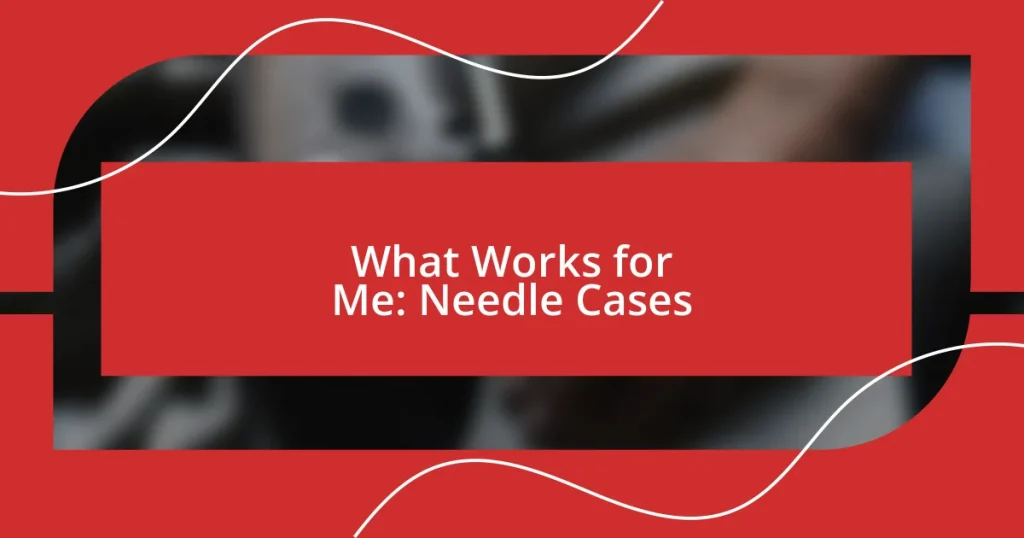Key takeaways:
- Group Pattern Testing harnesses collective insights from diverse team perspectives, enhancing creativity and innovation in user experience design.
- Effective collaboration is maintained through clear objectives, established roles, and open communication, fostering stronger teamwork and immediate feedback.
- Utilizing digital tools and encouraging participation creates an engaging environment, allowing for richer data collection and collective learning during testing sessions.

Overview of Group Pattern Testing
Group Pattern Testing is a collaborative approach that focuses on understanding user behavior by analyzing shared patterns among groups. I remember the first time I participated in such testing; it felt like being part of a grand puzzle where each piece represented a user’s experience. Isn’t it fascinating how these collective insights can drive significant design decisions?
This method allows teams to identify common themes across various profiles, revealing how different users interact with a product. I often felt a surge of excitement when patterns emerged on the screen, almost like discovering hidden treasures in the data. Have you ever noticed how some features resonate universally while others only attract a niche audience? Reflecting on these experiences really highlights the power of group dynamics in shaping user interaction.
Moreover, Group Pattern Testing fosters an open dialogue among team members, enhancing creativity and innovation in problem-solving. I distinctly recall brainstorming sessions that unfolded after uncovering insights from our tests—everyone brought a unique perspective, making the process feel vibrant and empowering. How often do we underestimate the value of collaboration in our projects? In my experience, those moments of shared exploration lead to breakthroughs that truly resonate with our users.

Benefits of Collaborative Testing
Collaborative testing is incredibly rewarding, as it taps into the diverse expertise of each team member. I once took part in a session where a designer and a developer shared their perspectives side by side. Their discussions illuminated critical usability challenges we might have overlooked individually. This interplay of ideas not only enriched our findings but also fostered a stronger sense of teamwork, reminding us that our collective knowledge is our greatest asset.
Another benefit I appreciate is the ability to gain instant feedback during the testing process. When testing with a group, the interplay of thoughts can lead to immediate adjustments. I vividly recall a moment when we all realized a particular feature confused users. The lively debate that ensued allowed us to pivot on the spot and refine our approach. Isn’t it exciting to see how quickly a team can adapt and innovate when everyone contributes their voice?
Lastly, the camaraderie built through collaborative testing is both invigorating and motivating. When I remember those testing sessions filled with laughter and shared “aha!” moments, it’s clear how much we fed off each other’s enthusiasm. There’s something special about collaborating; it transforms a potentially solitary task into a shared adventure. Have you ever felt that collective energy at work? It certainly makes the challenge of testing feel more like a team sport rather than an isolated endeavor.
| Benefits | Individual Testing |
|---|---|
| Collaborative Testing | Stronger Team Dynamics and Immediate Feedback |
| Shared Perspectives | Limited Insights |
| Enhanced Creativity | Less Innovation |

Key Strategies for Effective Testing
Testing effectively in a group setting requires strategic focus and organization. In my experience, one key strategy is to define clear objectives before diving into the testing phase. This ensures everyone is aligned and aware of what we aim to uncover. For instance, during one memorable session, we pinpointed our goal as understanding user navigation through a specific feature, which ultimately guided the entire process. When the team shares a unified vision, it genuinely amplifies the quality of insights gathered.
Here are some strategies I’ve found particularly useful:
- Establish Roles: Assign specific roles to team members to streamline the testing process—this can include facilitators, note-takers, and participants to avoid confusion.
- Emphasize Open Communication: Encourage every team member to voice thoughts and opinions during discussions. I’ve seen how a single comment can spark groundbreaking ideas.
- Utilize Visual Aids: Whether it’s wireframes or user journey maps, visual representations during testing can help the team quickly identify trends and inconsistencies.
- Schedule Reflection Time: After each test session, I’ve found it crucial to carve out time for reflection. Discussing what worked and what didn’t fosters continuous improvement and deeper understanding.
Consistency is another vital aspect of group pattern testing. I remember working through multiple iterations of a test cycle where we applied insights from previous sessions. As we gradually refined our approach, the differences in user interactions became starkly clear. Regularly revisiting the data and outcomes fostered a culture of resilience and adaptability—qualities that I believe are invaluable in this field.

Challenges in Group Testing
One significant challenge I’ve encountered in group testing is managing diverse opinions. It’s not unusual for team members to hold strong, differing views based on their backgrounds. I vividly remember a session where our group was split on the usability of a feature. The debate became so heated that it initially felt more like a conflict than collaboration. How do you ensure that such spirited discussions turn into constructive outcomes? I’ve learned that using a structured debate format can help channel those strong feelings into valuable insights instead of frustration.
Another hurdle is keeping everyone engaged and focused during long testing sessions. It’s easy for attention to wane as the hours go by, and I’ve witnessed this firsthand. During one particularly drawn-out session, I noticed some participants began checking their phones. It made me reflect on how vital it is to incorporate breaks and interactive activities to keep energy levels high. Isn’t it challenging when enthusiasm dips right when you need it most? I often suggest rotating roles or conducting quick brainstorming exercises to reinvigorate the group.
Finally, I must mention the issue of time management. Group testing can be time-consuming, especially when consensus is needed for decision-making. I recall one project where we spent far too long debating minor details while losing sight of our main objectives. Have you experienced that moment of realizing time is slipping away? It’s a fine balance to encourage thorough discussion while still keeping an eye on the clock. From that experience, I now advocate for setting strict time limits for discussions, ensuring we make timely and informed decisions without derailing the entire process.

Tools to Enhance Group Testing
When it comes to enhancing group testing, utilizing digital collaboration tools can be a game-changer. In my experience, platforms like Miro or Trello have transformed how we map out our ideas and feedback. For instance, during one particular testing session, I introduced a shared board where team members could pin their observations in real-time. It was exciting to see how these visual cues sparked conversations and led to insights we might have missed if we relied solely on verbal discussion.
Another essential tool that has served me well is video conferencing software. I once coordinated a remote group testing session where we could record discussions and capture reactions. At first, I worried about the participant’s energy in a virtual space. Surprisingly, having that footage allowed us to rewatch and analyze specific moments that could have easily been forgotten. Isn’t it fascinating how revisiting footage can uncover details that slip through when we’re immersed in the moment?
Integrating feedback tools, like Google Forms or Typeform, can also streamline the collection of participant impressions. I often send out quick pulse surveys post-session to gauge feelings about various aspects of the test. This approach not only enriches our data but also ensures every voice is heard, which I’ve found to be particularly rewarding. Reflecting back, I remember an instance where one team member flagged a recurring theme in the feedback that completely changed our direction. Such moments underline the value of actively listening and adapting our approach based on collective input.

Personal Experiences in Testing
Testing in a group setting has often enriched my perspective, providing firsthand insights that would have been difficult to achieve alone. For instance, there was a moment during a testing session when I noticed a quieter team member finally muster the confidence to share their viewpoint. The relief on their face was palpable, and it reminded me of the importance of creating an environment where everyone feels respected and empowered to contribute. How can we foster this dynamic in our testing groups? I’ve found that starting with icebreakers can break the initial tension and encourage more reserved individuals to join in the conversation.
Participating in group testing also allows me to learn from others’ approaches and strategies. I recall a session where a colleague presented a unique testing methodology that I had never considered. Watching them passionately share their process not only sparked my interest but also inspired me to adopt elements of their approach in my future tests. This collaborative learning experience is genuinely invaluable; it makes me wonder—how often do we tap into the wealth of knowledge that exists within our teams during these sessions?
Lastly, there’s something profoundly satisfying about seeing collective progress unfold in real-time. I once facilitated a group test where we swiftly moved from brainstorming ideas to observing results. Witnessing the group’s excitement as we identified strong patterns together felt exhilarating. It’s moments like those that reaffirm my belief in the power of collaboration. What if we shifted our mindset to view testing as a shared adventure? I truly believe our outcomes improve dramatically when we frame our challenges as a team, rather than as isolated tasks to be checked off.















